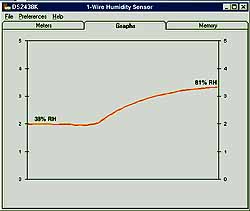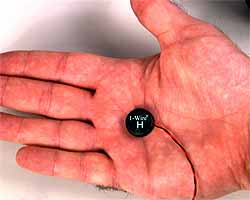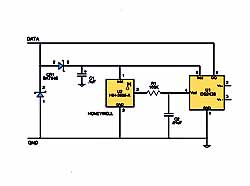A 1-Wire
Humidity Sensor
A humidity sensor designed for retrofit into a 1-Wire weather station is powered by and communicates over a single twisted pair.
Dan Awtrey,
Dallas Semiconductor


Simply holding the 1-Wire humidity sensor in an open hand can
raise the reported output substantially due to the evaporation of
moisture from the body. In the example shown, the change is a rise
from 38% to 81% RH.
Dallas Semiconductor, in conjunction with Texas Weather Instruments, Inc., previously developed a basic weather station that used 1-Wire technology to measure wind speed, wind direction, and temperature [1]. The station痴 capability was next expanded to include a rain gauge that was connected to the 1-Wire net by simply plugging it into the expansion connector on the weather station board [2]. Because 1-Wire technology transmits both power and bidirectional data over a single twisted-pair cable [3,4], no extra wiring or power was required.
A PC or microcontroller executing Touch Memory Executive (TMEX) software controls the 1-Wire net. Data transfers are half duplex and bit sequential over a single twisted-pair cable using short and long time slots to encode the binary ones and zeros, while power is transmitted during communication idle times. Because every 1-Wire device has a unique ID address that identifies it to the bus master, multiple sensors can share the same net and the software can automatically recognize and display data.
It痴 in the Chips
To calculate true relative humidity (RH) with a ratiometric sensor requires that the supply voltage, sensor temperature, and output voltage all be measured. Conveniently, all three sensor parameters can be monitored with a single, new 1-Wire IC. The DS2438 Smart Battery Monitor, designed to work in battery packs to perform multiple functions such as tagging and fuel gauging, contains the voltage and temperature A/D converters needed for RH calculations. The device also contains a 10 bit current converter, a current accumulator, and an elapsed time meter that can be used for other sensors which will be described at a later time. The monitor also provides 40 bytes of nonvolatile memory that can provide a useful storage area for calibration or location information.
sensor RH = (VOUT /
VSUPPLY) ・0.16 / 0.0062, typical at 25ーC To correct the calculation for temperature and
compute true RH, use: true RH = sensor RH / (1.0546 ・0.00216
T) where T is in ーC Since the DS2438 reports temperature in ーC,
this is the most convenient formula for use with the 1-Wire humidity
sensor. If temperature is known in ーF, however, true RH can be
calculated by: true RH = sensor RH / (1.093 ・0.0012
T) where T is in ーF
Calculating True
Relative Humidity
The output of the
Honeywell HIH-3605 humidity sensor is an analog voltage proportional
to the supply voltage. Consequently, converting it to relative
humidity (RH) requires that both the supply and sensor output
voltages be taken into account according to the formula:
The Honeywell HIH-3605 humidity sensor chosen is a monolithic IC containing a laser-trimmed capacitive sensing element with onchip signal conditioning. It develops a linear voltage vs. RH output that is ratiometric to the supply voltage. That is, when the supply voltage varies, the sensor output voltage follows in the same proportion. The part is calibrated at 5 VDC, but it will operate over a 4・.8 VDC range. At the calibration voltage and room temperature, the output voltage ranges from 0.8 to 3.9 VDC as the humidity varies from 0% to 100% (noncondensing). At 200 mA, its operating current is well suited for use on a 1-Wire net. Since the part is light sensitive, it should be shielded from bright lights when in operation.
Measuring RH via the 1-Wire Net

Figure 1. Power for the sensor is provided by CR1 and C1.
To compute relative humidity, the DS2438 reads the voltage across
the sensor, Vdd, and the sensor output, Vad. The DS2438 also
provides temperature compensation with a 13 bit temperature sensor.
R1 and C2 provide low-pass
filtering.
In the circuit shown in Figure 1, C1 and one of the Schottky diodes in CR1 form a half-wave rectifier that provides power for both the sensor and the battery monitor by 都tealing・it from the bus when it is at 5 V during idle communication periods. This is a discrete implementation of the parasite power technique used internally by 1-Wire devices to provide their own operating power. The remaining Schottky diode connected across DATA and GND provides circuit protection by clamping signal excursions that go below ground to ~0.4 V. Under bus master control U1, the DS2438 monitors the supply voltage available to U2, the humidity sensor, and its own Vdd (pin 5). It then measures U2痴 output seen on its analog input pin 4. Finally, the DS2438 reports temperature in ーC from its internal 13 bit converter. Software then uses these data to compute and display true relative humidity.
Summary
A humidity sensor designed for retrofit into a 1-Wire weather station is powered by and communicates over a single twisted pair. Because of their unique ID addresses, multiple copies of the sensor can be arbitrarily placed anywhere on the 1-Wire net to track ambient moisture content over a specified area such as a greenhouse.
1-Wire, TMEX, and 1-Wire net are trademarks of Dallas Semiconductor.
Acknowledgments
The author wishes to thank Mike Bolan, Mike Overlaur, and Jason Cole, who provided the support necessary to develop the humidity sensor.
References
1. Dan Awtrey. June 1998. 典he 1-Wire Weather Station,・Sensors, Vol. 15, No. 6:34-40.
2. 覧・ Dec. 1999. 鄭 1-Wire Rain Gauge,・Sensors, Vol. 16, No. 9:56-59.
3. 覧・ Feb. 1997. 典ransmitting Data and Power over a One-Wire Bus,・Sensors, Vol. 14, No. 2:48-51.
4. 覧・ 1-Wire Net Design Guide, www.dalsemi .com/TechBriefs/tb1.html.
Dan Awtrey is a Staff Engineer, Dallas Semiconductor, 4401 S. Beltwood Pkwy., Dallas, TX 75244-3292; 972-371-6297, fax 972-371-3715, dan.awtrey@dalsemi.com.
For information about 1-Wire sensors, contact John Compton, CEO, Point Six, Inc., 383 Codell Dr., Lexington, KY 40509; 606-266-3606, fax 606-266-0702, http://www.pointsix.com/.